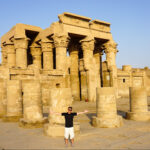Embark on a virtual expedition to Karnak Temple, an unparalleled ancient Egyptian art and architecture masterpiece. Nestled on the east bank of the Nile River in Luxor, Egypt, this temple complex is a living testament to the magnificence of the pharaohs’ reign. Colossal structures, detailed hieroglyphics, and spiritual significance make it an enduring symbol of human ingenuity and devotion.
Unveiling the Grandeur: Karnak Temple Explored
A Glimpse into Ancient Egypt’s Heart
Immerse yourself in the enchanting world of Karnak Temple, an architectural marvel that has withstood the test of time. From the Great Hypostyle Hall to the Sacred Lake, every corner exudes a sense of wonder, inviting you to delve into the past.
The Majestic Hypostyle Hall
Behold the awe-inspiring grandeur of the Hypostyle Hall, an immense forest of towering columns adorned with intricate carvings. The play of light and shadow creates an ethereal ambiance, transporting visitors to a bygone era of ceremonies and rituals.
Traversing the Avenue of Sphinxes
Walk in the footsteps of pharaohs as you stroll along the Avenue of Sphinxes, a grand procession that once connected Karnak to Luxor Temple. The graceful alignment of these mythical creatures beckons you to unravel the mysteries of ancient caravans.
The Enigmatic Obelisks of Karnak Temple
Marvel at the colossal obelisks punctuating the temple complex, each bearing inscriptions narrating tales of victory and devotion. These monolithic structures stand as proud sentinels, commemorating the power and influence of Egypt’s rulers.
Mythical Sanctuaries: Temples Dedicated to the Gods

Explore the interconnected temples within Karnak Temple, each dedicated to a different deity. From the sacred precinct of Amun-Ra to the graceful allure of Mut’s sanctuary, discover the spiritual significance of these hallowed grounds.
Secrets of the Sacred Lake
Uncover the enigmatic purpose of the Sacred Lake, a reflective oasis that played a vital role in the temple’s rituals. Its tranquil waters once mirrored the heavens above, serving as a conduit between the mortal and divine realms.
Architectural Marvels: Pillars and Pylons
Delve into the architectural prowess of Karnak Temple’s pillars and towers, masterfully designed to convey power and permanence. The intricate details and inscriptions glimpse the religious fervor that drove their creation.
Carvings that Chronicle History
Trace the history of Egypt through the intricate carvings that adorn Karnak Temple’s walls. These vivid depictions offer insights into religious ceremonies, military campaigns, and the daily life of the ancient Egyptians.
The Sacred Botanical Garden
Experience the tranquility of the Sacred Botanical Garden, a serene oasis where exotic flora once flourished. As you wander through this verdant haven, contemplate the relationship between nature and spirituality.
Navigating the Complex: Practical Tips
Plan your visit to Karnak Temple easily using these practical tips. From entry timings to guided tours, ensure a seamless exploration of this archaeological gem.
Beyond the Temple: Luxor’s Historical Treasures
Extend your journey to explore other captivating sites in Luxor, such as the Valley of the Kings, Luxor Temple, and the Colossi of Memnon. Each destination offers a unique glimpse into Egypt’s illustrious past.
Rediscovering Ancient Wisdom
Engage with the wisdom of the pharaohs and priests as you decipher the hieroglyphics adorning Karnak Temple. These inscriptions offer a portal to a time when knowledge was etched in stone and shared through sacred texts.
FAQs
How old is Karnak Temple?
It dates back over 4,000 years, with construction initiated during the Middle Kingdom and spanning various dynasties.
What was the purpose of Karnak Temple?
The primary purpose of Karnak Temple was to serve as a religious complex dedicated to the god Amun-Ra and other deities. It was a center for worship, ceremonies, and celebrations.
How long did it take to build Karnak Temple?
The construction of the Karnak Temple spanned multiple centuries, with different rulers contributing to its expansion and enhancement. The process of building and renovation continued over approximately 1,500 years.
What is the significance of the Hypostyle Hall?
The Hypostyle Hall was a central area for rituals and gatherings. Its impressive columns symbolized the connection between the earthly and divine realms, allowing priests and worshippers to commune with the gods.
Can visitors enter Karnak Temple today?
It is open to visitors, allowing them to explore its magnificent structures, carvings, and sanctuaries. Guided tours and informational panels provide insights into the temple’s history and significance.
Are there any special events held at Karnak Temple?
Periodically, the Temple hosts special events, such as sound and light shows, which bring the temple’s history to life through captivating multimedia presentations.
Conclusion
As you traverse the hallowed grounds of Karnak Temple, you journey through time, uncovering the mysteries of ancient Egypt’s spirituality and architectural prowess. The colossal columns, intricate carvings, and sacred spaces are a testament to the enduring legacy of a civilization that revered the gods and celebrated life’s complex tapestry. With its rich history and captivating allure, it invites you to immerse yourself in the splendor of a bygone era, leaving you with memories that will linger for a lifetime.




